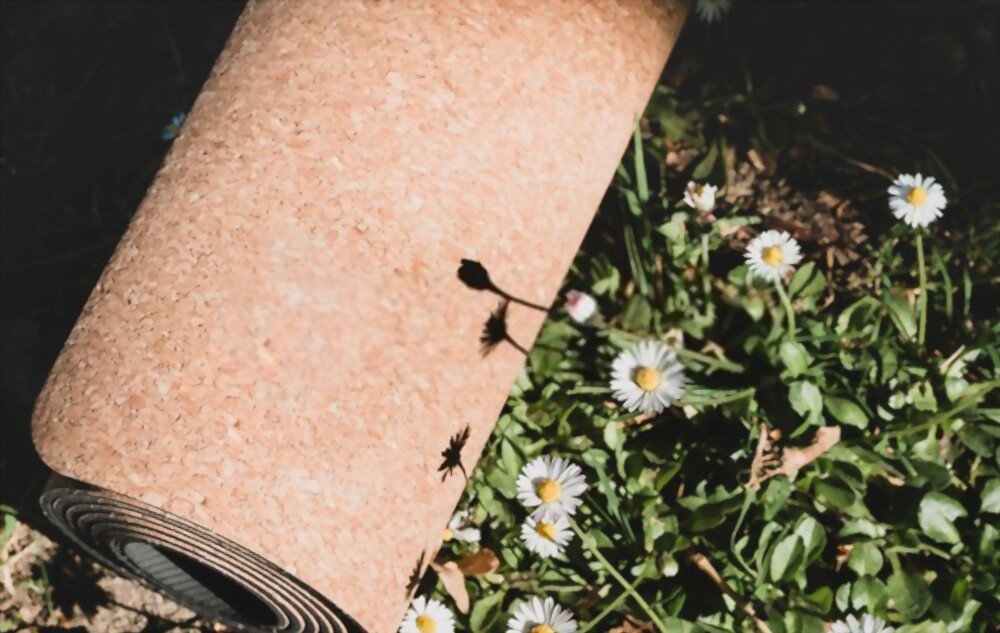Eco-friendly yoga mats

More and more manufacturers recognise growing consumer demand for sustainable yoga mats. But what does it mean exactly? Does eco-friendly automatically mean that a product is safe for your health? Below are some information on the most common mats available today.
PVC
When I started looking for sustainable yoga mats, I quickly discovered that PVC mats were out of the question.
To begin, polyvinyl chloride (PVC) is made from petroleum and is the most toxic plastic for health and the environment. Its advantages are that as a building material, PVC is cheap, easy to install and to replace. That is why it replaces wood, concrete, and clay in many areas. However, as consumers, we hardly know the entire scope of its high environmental and human health costs.
PVC emits toxic compounds throughout its life cycle, starting with its manufacture and ending with its disposal. When in use, PVC products can leach toxic additives, such as phthalates. On top of that, PVC cannot be easily recycled. So, it continues emitting toxic substances in the landfill, or if incinerated, emits dioxins and heavy metals. As of today, there is no safe way to manufacture, use or dispose of PVC products.
TPE
Is TPE material the answer for producing sustainable yoga mats? TPE (thermoplastic elastomers) are a mix of polymers, such as rubber and plastic. Do these sound like proper materials for eco-friendly yoga mats? My first yoga mat was made from TPE and I can vividly remember the toxic smells emitted when I removed the polypropylene film wrap. This smell remained for weeks and I dread to think the amount of synthetic fumes that I must have inhaled in that time. At the time I bought it only because it was advertised as eco-friendly without doing any research.
According to the British Plastics Federation, there are seven main TPE groups available commercially. For example, one of the most common and least expensive ones is Styrenic Block Copolymers. To clarify, these are based on two-phase block copolymers with hard and soft segments. Thus, the styrene end blocks provide thermoplastic properties, and the butadiene mid-blocks provide elastomeric properties. Considering its properties and areas of application, I venture a guess that some so-called sustainable yoga mats are made with this kind of TPE. In short, TPE is a blend of undisclosed synthetic materials that have not been proven safe.
You would expect sustainable yoga mats to be biodegradable, right? However, the term “biodegradable” is hard to regulate, in the first place. How long does the break down process take – days or years? What conditions can the object break down in – a plastic bag in the landfill, a compost bin, a specialized municipal facility? What chemicals will it break down into? Some biodegraded compounds may be more toxic than the original ones.
Rubber
Is rubber better? It has excellent properties being non-slippery and provides good cushioning, but it does smell even after several weeks of use. Natural rubber is better than synthetic rubber As a petroleum-derived material, synthetic rubber may contain polycyclic aromatic hydrocarbons (PAHs) and heavy metals.
Cork/natural rubber
Cork is the best material for a yoga mat because it is durable, environmentally friendly, and non-toxic. Cork is made from the bark of oak trees grown in Portugal that live up to 300 years! Importantly, it is sustainably re-harvested from the same tree every 9 years.
As a material it provides the cushioning and support needed. Plus, there are no known health or environmental concerns associated with it. Unfortunately, cork mats without backing are unlikely to stay in place – they will slide. That is why backing is a must. Though not perfect, natural rubber is much better than synthetic rubber. Indeed, it is not a petroleum product, and, reportedly, is biodegradable. There is a chemical smell if you press your nose on the natural rubber side. However, you do not need to as you will be facing the cork layer.
The good news is that the cork is naturally antimicrobial. It means that you do not need to worry about germs, mould, and mildew or frequent cleaning. Just lay the mat flat after practice to air dry. Do not use a washing machine! If there is dirt or body oils, wipe the surface with a damp soft cloth wet in warm water.
